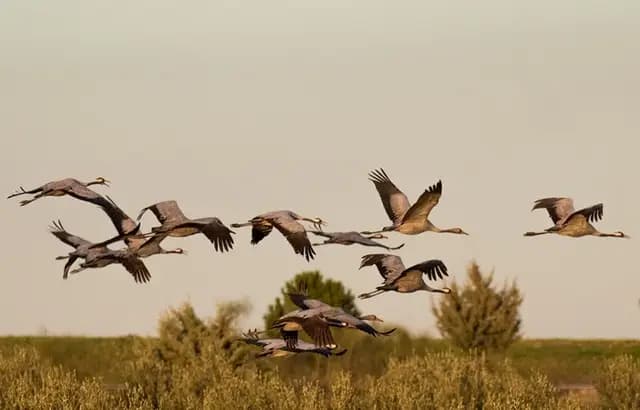Nouvelle-Aquitaine: In Winter, Tens of Thousands of Common Cranes Come to Seek “Food and Shelter”

NATURE: Several tens of thousands of common cranes spend the winter in Nouvelle-Aquitaine, especially in the Landes de Gascogne and around the Cousseau pond reserve, in the Médoc
- The Common Crane breeds in summer around the Baltic Sea, and in winter moves in western France, Spain and sometimes the Maghreb.
- In the region, there are up to 50,000 birds in the Landes de Gascogne.
- In the evening, several thousand of them come to spend the night on the Cousseau pond nature reserve, in Gironde.
Their flight so sonorous is a spectacle that always makes you roll your eyes. So, when several groups of hundreds of common cranes land at the same time, in the evening on the national nature reserve of the Cousseau pond in Gironde, “it’s impressive, and it’s as much visual as sound, there is everything. an atmosphere ”assures Vincent Rocheteau, guard animator at the reserve.

Located in the Médoc between Carcans and Lacanau, and spanning nearly 1,000 hectares, the Cousseau pond nature reserve, and in particular the Coutin estate, carries out counts every fortnight, to monitor changes of the species. On November 30, more than 6,000 cranes, also called “Gray ladies”, returned in the evening to the domain, a site protected and managed by Sepanso (Society for the study, protection and development of nature in the southwest). Across the Landes de Gascogne, the population of common cranes is around 40,000 birds, sometimes 50,000, during the winter.
“The particularity of sleeping with your feet in the water”
“It’s a bird that breeds around the Baltic Sea,” explains Vincent Rocheteau. As soon as there begins to be the first cold and the first snows on Moscow and Saint Petersburg, the birds return to the west to have access to food, the lake of Der in Champagne-Ardennes being their migratory crossroads. And as soon as the cold hits eastern France, the birds glide over the centre of the country, New Aquitaine, then for some the Iberian Peninsula or even the Maghreb. Another part of the Common Cranes takes a different path, passing through Eastern Europe to migrate to the edge of Asia.

In Nouvelle-Aquitaine, the very first ones arrive in mid-October. “But the first large abundances are not there until mid-November. »In winter, the crane lives in groups. “They all sleep on top of each other during the night, and they have the particularity of sleeping with their legs in the water. They need a sheet of water to allow them to see the predator – like a fox – coming. The Médoc marshes are very interesting in this, since they are extensive marshes but with very low water levels. ”
“Most of the migration usually takes place around February 10-15th
If the crane goes to the marshes to sleep at night, during the day it travels over the region’s large corn-growing areas, particularly in the Landes, to feed on corn residues. “What interests them with us is, therefore, food and lodging” summarizes Vincent Rocheteau.
Concentrations of birds in the area may increase until mid-January when it is coldest in the east. “After mid-January, we will start to see the first birds coming back from Spain, continues Vincent Rocheteau: the cranes indeed feel that the sun is coming back slowly. But the bulk of the migration usually takes place around February 10-15. On beautiful sunny afternoons, this is where we will see large groups of cranes pass over Bordeaux. “
Threatened with extinction in the 1970s, the common crane is today a protected species. But it is also the protection of its habitat that has allowed it to regain color. “The biggest danger for this species, however, remains the loss of its natural environment,” insists Vincent Rocheteau. In summer, it needs wetlands to reproduce, and on a European scale, these have declined sharply in recent years. “
La Sepanso is organizing a visit to the Cousseau nature reserve on Saturday 19 December, to admire these birds when they wake up between 7:30 and 11 a.m.
Enjoyed this? Get the week’s top France stories
One email every Sunday. Unsubscribe anytime.


